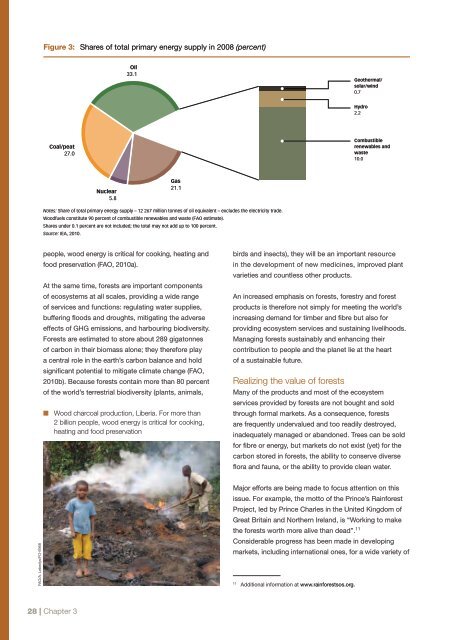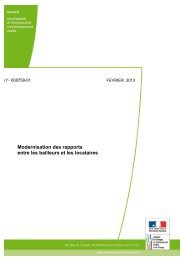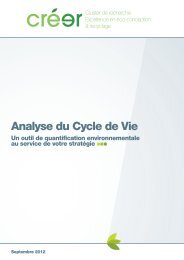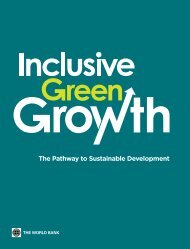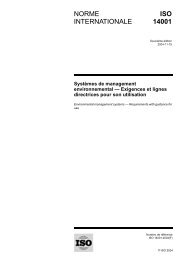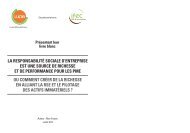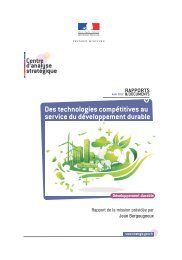Figure 3: Shares <strong>of</strong> total primary energy supply in 2008 (percent)Oil33.1Geo<strong>the</strong>rmal/solar/wind0.7Hydro2.2Coal/peat27.0Combustiblerenewables andwaste10.0Nuclear5.8Gas21.1Notes: Share <strong>of</strong> total primary energy supply – 12 267 million tonnes <strong>of</strong> oil equivalent – excludes <strong>the</strong> electricity trade.Woodfuels constitute 90 percent <strong>of</strong> combustible renewables and waste (FAO estimate).Shares under 0.1 percent are not included; <strong>the</strong> total may not add up to 100 percent.Source: IEA, 2010.people, wood energy is critical for cooking, heating andfood preservation (FAO, 2010a).At <strong>the</strong> same time, forests are important components<strong>of</strong> ecosystems at all scales, providing a wide range<strong>of</strong> services and functions: regulating water supplies,buffering floods and droughts, mitigating <strong>the</strong> adverseeffects <strong>of</strong> GHG emissions, and harbouring biodiversity.<strong>Forests</strong> are estimated to store about 289 gigatonnes<strong>of</strong> carbon in <strong>the</strong>ir biomass alone; <strong>the</strong>y <strong>the</strong>refore playa central role in <strong>the</strong> earth’s carbon balance and holdsignificant potential to mitigate climate change (FAO,2010b). Because forests contain more than 80 percent<strong>of</strong> <strong>the</strong> world’s terrestrial biodiversity (plants, animals,■■Wood charcoal production, Liberia. For more than2 billion people, wood energy is critical for cooking,heating and food preservationbirds and insects), <strong>the</strong>y will be an important resourcein <strong>the</strong> development <strong>of</strong> new medicines, improved plantvarieties and countless o<strong>the</strong>r products.An increased emphasis on forests, forestry and forestproducts is <strong>the</strong>refore not simply for meeting <strong>the</strong> world’sincreasing demand for timber and fibre but also forproviding ecosystem services and sustaining livelihoods.Managing forests sustainably and enhancing <strong>the</strong>ircontribution to people and <strong>the</strong> planet lie at <strong>the</strong> heart<strong>of</strong> a sustainable future.Realizing <strong>the</strong> value <strong>of</strong> forestsMany <strong>of</strong> <strong>the</strong> products and most <strong>of</strong> <strong>the</strong> ecosystemservices provided by forests are not bought and soldthrough formal markets. As a consequence, forestsare frequently undervalued and too readily destroyed,inadequately managed or abandoned. Trees can be soldfor fibre or energy, but markets do not exist (yet) for <strong>the</strong>carbon stored in forests, <strong>the</strong> ability to conserve diverseflora and fauna, or <strong>the</strong> ability to provide clean water.FAO/A. Lebedys/FO-6968Major efforts are being made to focus attention on thisissue. For example, <strong>the</strong> motto <strong>of</strong> <strong>the</strong> Prince’s RainforestProject, led by Prince Charles in <strong>the</strong> United Kingdom <strong>of</strong>Great Britain and Nor<strong>the</strong>rn Ireland, is “Working to make<strong>the</strong> forests worth more alive than dead”. 11Considerable progress has been made in developingmarkets, including international ones, for a wide variety <strong>of</strong>11Additional information at www.rainforestsos.org.28 | Chapter 3
enewable NWFPs (such as nuts and fruits), withresulting benefits for forest-dependent communities.A resilient and durable economy will incorporate abroader range <strong>of</strong> forest values in decision-makingprocesses. Where markets are non-existent orunderdeveloped, public policies can play an essential rolein identifying and promoting recognition <strong>of</strong> <strong>the</strong>se forestvalues. Current actions by governments, civil society and<strong>the</strong> private sector to ensure greater attention to forestvalues include efforts to create markets that underpinReducing Emissions from Deforestation and ForestDegradation (REDD) (Box 4). As a consequence, <strong>the</strong>re isbroad consensus that sustainable management <strong>of</strong> forestsis an important goal for all countries, and that it shouldinclude a greater emphasis on conserving and enhancingforest-based carbon stocks. In moving to a sustainableeconomy, deforestation and forest degradation must besignificantly reduced and net global forest area increased.Forestry in a sustainable futureForestry is <strong>the</strong> art and science <strong>of</strong> creating, using andconserving forests. The forestry pr<strong>of</strong>ession was a pioneerin developing techniques for sustainable managementand, later, techniques for <strong>the</strong> multiple use <strong>of</strong> forests.More recently, broad holistic concepts such asecosystem management and landscape managementhave been developed, tested and applied.These are all elements <strong>of</strong> <strong>the</strong> sustainability andsustainable management <strong>of</strong> a wide variety <strong>of</strong> renewableresources. However, forestry is embedded in a changing,predominantly urban society that has limited directexperience <strong>of</strong> nature and is frequently sceptical <strong>of</strong>resource managers. Although <strong>the</strong> term “sustainableforest management” is synonymous with “good forestry”,forestry and forest management are sometimes viewedas potentially damaging to <strong>the</strong> environment. This fearis justified where unscientific or illegal forest practicesare used, but <strong>the</strong> argument that <strong>the</strong>re is a need to “green<strong>the</strong> forest sector” appears to give too little credit t<strong>of</strong>orestry’s core concepts (see, for example, UNEP, 2011).Never<strong>the</strong>less, if forestry is to contribute effectively, it mustcontinue to evolve.Forestry is “sandwiched” between two extreme andconflicting views: on one side are <strong>the</strong> superficial, mainlyurban, perceptions <strong>of</strong> <strong>the</strong> felling <strong>of</strong> a tree or <strong>the</strong> hunting<strong>of</strong> forest wildlife as environmental <strong>of</strong>fences; and on <strong>the</strong>o<strong>the</strong>r side are <strong>the</strong> poor practices and negative impactson forests that generally come from outside forestry (fires,pollution, etc.) or from mining and o<strong>the</strong>r interests thatperceive forest lands as reservoirs <strong>of</strong> land for mineralextraction, agriculture, etc. The tools for dealing with<strong>the</strong>se extremes are effective communication for <strong>the</strong> firstand land-use planning and enforcement for <strong>the</strong> second.A significant challenge for <strong>the</strong> forestry pr<strong>of</strong>ession isto communicate and demonstrate <strong>the</strong> simple ideathat one <strong>of</strong> <strong>the</strong> best ways <strong>of</strong> saving a forest is touse it. When looking for ways to stimulate economicdevelopment, politicians and planners seldom seeall <strong>the</strong> dimensions and potential <strong>of</strong> <strong>the</strong> forest sector.<strong>Forests</strong> are viewed as ei<strong>the</strong>r a feature <strong>of</strong> <strong>the</strong>environment to be preserved or, in stark contrast,a source <strong>of</strong> land to aid <strong>the</strong> expansion <strong>of</strong> agriculture.A balance should be found in which forestscontribute to achieving all <strong>of</strong> <strong>the</strong>se goals: sustainableforest management adds value to a forest by usingBox 4: Is REDD a “game changer”?In The Future <strong>of</strong> <strong>the</strong> World’s <strong>Forests</strong>, Jim Douglas and MarkkuSimula suggest that <strong>the</strong> opportunity to receive paymentsfor reduced deforestation through carbon emission tradingis a “game changer” because it represents <strong>the</strong> internationalcommunity’s first attempt to develop a global mechanism thatrecognizes non-market values from forests – in this instance<strong>the</strong> contribution to mitigating climate change through carbonsequestration.The authors acknowledge that carbon storage is onlyone <strong>of</strong> several forest ecosystem services that are not valuedby markets, but it is <strong>the</strong> first such value that people areaddressing formally by seeking to create a global market.Noting that deforestation is caused mainly by economicforces outside <strong>the</strong> forest sector, <strong>the</strong> authors conclude that“it will not be easy to use broad based economic reform asa primary means <strong>of</strong> implementing a revaluation <strong>of</strong> existingrainforests: it is simply too blunt an instrument.”The authors <strong>the</strong>refore describe <strong>the</strong>mselves as “REDDoptimists” in <strong>the</strong>ir hope that payments for reducingdeforestation will be a significant accomplishment in effortsboth to mitigate climate change and to finance sustainableforest management adequately (Douglas and Simula, 2010).<strong>Forests</strong>, forestry and forest products for a sustainable future | 29


